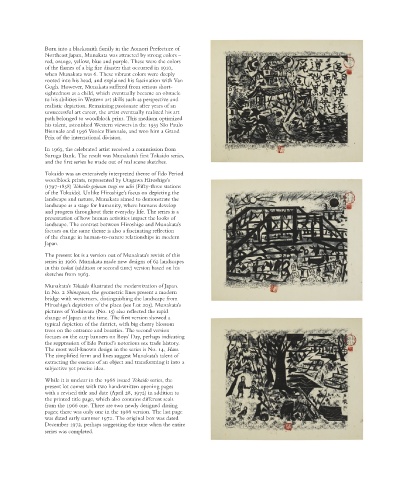Page 388 - japanese and korean art Utterberg Collection Christie's March 22 2022
P. 388
Born into a blacksmith family in the Aomori Prefecture of
Northeast Japan, Munakata was attracted by strong colors –
red, orange, yellow, blue and purple. These were the colors
of the flames of a big fire disaster that occurred in 1910,
when Munakata was 6. These vibrant colors were deeply
rooted into his head, and explained his fascination with Van
Gogh. However, Munakata suffered from serious short-
sightedness as a child, which eventually became an obstacle
to his abilities in Western art skills such as perspective and
realistic depiction. Remaining passionate after years of an
unsuccessful art career, the artist eventually realized his art
path belonged to woodblock print. This medium optimized
his talent, astonished Western viewers in the 1955 São Paulo
Biennale and 1956 Venice Biennale, and won him a Grand
Prix of the international division.
In 1963, the celebrated artist received a commission from
Suruga Bank. The result was Munakata’s first Tokaido series,
and the first series he made out of real scene sketches.
Tokaido was an extensively interpreted theme of Edo Period
woodblock prints, represented by Utagawa Hiroshige’s
(1797-1858) Tokaido gojusan tsugi no uchi (Fifty-three stations
of the Tokaido). Unlike Hiroshige’s focus on depicting the
landscape and nature, Munakata aimed to demonstrate the
landscape as a stage for humanity, where humans develop
and progress throughout their everyday life. The series is a
presentation of how human activities impact the looks of
landscape. The contrast between Hiroshige and Munakata’s
focuses on the same theme is also a fascinating reflection
of the change in human-to-nature relationships in modern
Japan.
The present lot is a version out of Munakata’s revisit of this
series in 1966. Munakata made new designs of 62 landscapes
in this tsukai (addition or second time) version based on his
sketches from 1963.
Munakata’s Tokaido illustrated the modernization of Japan.
In No. 2 Shinagawa, the geometric lines present a modern
bridge with westerners, distinguishing the landscape from
Hiroshige’s depiction of the place (see Lot 205). Munakata’s
pictures of Yoshiwara (No. 15) also reflected the rapid
change of Japan at the time. The first version showed a
typical depiction of the district, with big cherry blossom
trees on the entrance and beauties. The second version
focuses on the carp banners on Boys’ Day, perhaps indicating
the suppression of Edo Period’s notorious sex trade history.
The most well-known design in the series is No. 14, Hara.
The simplified form and lines suggest Munakata’s talent of
extracting the essence of an object and transforming it into a
subjective yet precise idea.
While it is unclear in the 1966 issued Tokaido series, the
present lot comes with two hand-written opening pages
with a revised title and date (April 28, 1972) in addition to
the printed title page, which also contains different seals
from the 1966 one. There are two newly designed closing
pages; there was only one in the 1966 version. The last page
was dated early summer 1972. The original box was dated
December 1972, perhaps suggesting the time when the entire
series was completed. 

